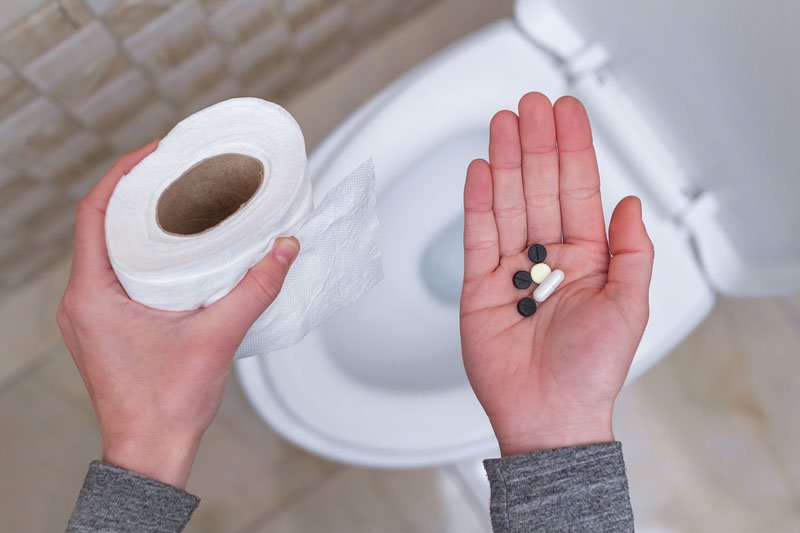Q: After I had my hip replaced, my surgeon recommended I take a stool softener for a couple of weeks to prevent constipation. Is that the same as a laxative?
Laxatives encourage movement of your stool through your intestines, helping to prevent and relieve the pain and pressure of constipation. The word laxative means “to loosen”, similar to the more common words “relax” and “lax”, meaning acting loose or relaxed. So, a laxative works to “loosen” your bowels, relieving constipation. Stool softeners are considered a particular type of laxative called an emollient laxative, used to lubricate the stool.
When you swallow a bite of food it starts down a series of tubes called your digestive tract. Highly acidic gastric juices are secreted by cells in the lining of your stomach, breaking down your food into a form that will eventually be absorbed into your body. Moving the mostly liquid mass of food from your stomach into your small intestine begins the process of absorbing the vital nutrients in the food that you just ate.
Your intestines are lined with special cells designed to absorb nutrients, medicines, and water. There’s also a layer of very important muscles that run the entire length of your intestines that keep that mass of food and liquid moving along, and whatever is left over is eliminated as stool or feces.
The longer it takes to move through your small intestine to your rectum, the more water gets pulled out of your stool, making it smaller, harder and more painful to eliminate. An emollient can soften the stool both by pulling moisture back into the stool and by lubricating it, easing the discomfort of constipation. The most common stool softeners are docusate and mineral oil.
Docusate is a surfactant very much like a detergent or soap, and helps water to move into your stool. Although docusate doesn’t directly stimulate the muscles of your intestines or increase the movement of stool, it can relieve constipation by replacing some of the water in your stool that is absorbed by your body as it moves through your intestine. Docusate is usually easy to tolerate but may occasionally cause diarrhea or stomach cramps. Unlike mineral oil, it doesn’t interfere with absorption of nutrients or vitamins.
Mineral oil is a liquid refined from crude oil. It lubricates the stool but doesn’t increase its water content like docusate. Mineral oil is colorless and odorless, and “baby oil” is a scented version of it. Mineral oil can interfere with your body’s absorption of fat-soluble vitamins like vitamin A, D, E and K, eventually causing a deficiency and also can leak out from your rectum. If you accidently inhale it while trying to swallow, mineral oil can cause life-threatening irritation to your lungs. Mineral oil usually stays in your intestine where it is needed, but if you take docusate and mineral oil together, the mineral oil can be absorbed into your body and away from where it can help relieve painful elimination.
Emollient laxatives like docusate and mineral oil may turn your stool “mushy” but don’t directly stimulate the muscles lining your intestine. While most people get results within 2 days, it can take up to five days for full effect.
Here are 5 Tips on Using a Stool Softener:
- Drink enough water and fluids, especially around mealtime.
This will help docusate do its job of helping move water into your stool.
- If you are on a sodium-restricted diet, choose docusate calcium instead.
Docusate has two forms, sodium and calcium. If you must restrict your sodium intake, choose docusate calcium instead of docusate sodium. It can be hard to find; if you don’t see it on the shelf, ask the pharmacist.
- If you have trouble with large pills, don’t buy 250mg docusate capsules.
The size of the capsules is hard to see through its dark bottle. Although the 250mg capsule is a better value than the 100mg because they cost the same, the 250mg capsule is HUGE and should not be cut.
- Avoid cutting or biting docusate capsules.
Docusate tastes HORRIBLE, just like soap, because that’s what it is. Avoid biting or cutting docusate capsules unless you like the soapy taste. The syrup is nearly as bad; it ranks consistently at the bottom of liquid taste tests and the aftertaste can linger for hours.
- For faster results, choose a combination laxative and stool softener.
Docusate is often combined with a more stimulating laxative like senna or bisacodyl. Senakot-S® and Peri-Colace® are examples of combination products.


